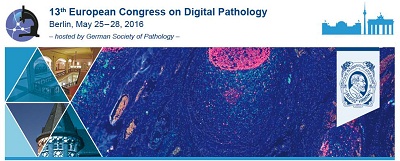Validation Of Virtual Double Staining For Estimation Of Ki67 Proliferation Indices In Breast Carcinomas
Abstract
Introduction/ Background
Ki67 is an important immunohistochemical marker of proliferation used in grading of breast cancer and endocrine neoplasms. Ki67 proliferation indices (PI) are calculated as number of Ki67 positive tumour cells divided by total number of tumour cells. However, manual counting and calculation of Ki67 proliferation index is laborious and prone to inter-observer variability. Recently, a computerized algorithm that enables virtual alignment of two consecutive slides stained for pancytokeratin and Ki67 has been developed. Digital image analysis (DIA) based on Virtual Double Staining (VDS) enables exclusion of stromal cells and calculation of Ki67 PI in tumour cells only.
Aims
The purpose of this study was to validate the VDS algorithm by comparing manual counting and DIA on VDS for assessment of Ki67 PI in breast carcinomas.
Methods
Tissue Micro Arrays (TMA) were constructed with 158 cores of breast carcinomas. Two slides were cut from each TMA and immunohistochemically stained for pancytokeratin and Ki67. For each core, between 2-20% of the total core area were selected for exact manual counting of Ki67-positive and negative cells using the stereological principle of systematic uniformly random sampling. A minimum of 200 cells were counted. The same areas were then counted using the VDS algorithm. Additionally, the VDS algorithm was used to calculate Ki67 PI for each core. In order two analyze the importance of the distance between neighbouring slides five consecutive slides were stained for PCK. These slides were digitally fused and the percentage of overlap between stained and not stained areas calculated. Additionally, the VDS principle was used to examine differences in Ki67 PI when the immunohistochemical staining protocol was based on different antibody clones (Mib1, SP6 and 30-9) and staining platforms (Dako Autostainer, Leica Bond and Ventana Ultra).
Results
There was good correlation (R2 >0.90, ICC >0.95) between manual counting in systematic randomized selected areas and DIA on VDS of both the whole core and in selected areas. Comparison of the two methods using Bland-Altman plots did not reveal any skewness in certain data ranges. Overlap agreement between neighbouring sections was on average above 88%, lower for diffusely infiltrating tumours than more solid tumours. Analysis revealed significant differences in calculated Ki67 PI between the different antibodies. The Mib1 and SP6 clones (concentrated format) were comparable on the Dako and Leica platform, while the average Ki67 PI for the SP6 clone was 44% higher on the Ventana platform. For the ready-to-use formats, Mib1 and MM1 based Ki67 PIs were 28% and 36% lower than average, while the clone 30.9 based Ki67 PI was 23% higher. In conclusion, DIA based on VDS may be an important future tool for improving accuracy and reproducibility of Ki67 PI in diagnostic and research settings.
Â
Downloads

This work is licensed under a Creative Commons Attribution-ShareAlike 4.0 International License.
Authors who publish with this journal agree to the following terms:
1. Authors retain copyright and grant the journal right of first publication with the work simultaneously licensed under a Creative Commons Attribution License that allows others to share the work with an acknowledgement of the work's authorship and initial publication in this journal.
2. Authors are able to enter into separate, additional contractual arrangements for the non-exclusive distribution of the journal's published version of the work (e.g., post it to an institutional repository or publish it in a book), with an acknowledgement of its initial publication in this journal.
3. Authors are permitted and encouraged to post their work online (e.g., in institutional repositories or on their website) prior to and during the submission process, as it can lead to productive exchanges, as well as earlier and greater citation of published work (See The Effect of Open Access).
4. In case of virtual slide publication the authors agree to copy the article in a structural modified version to the journal's VS archive.








